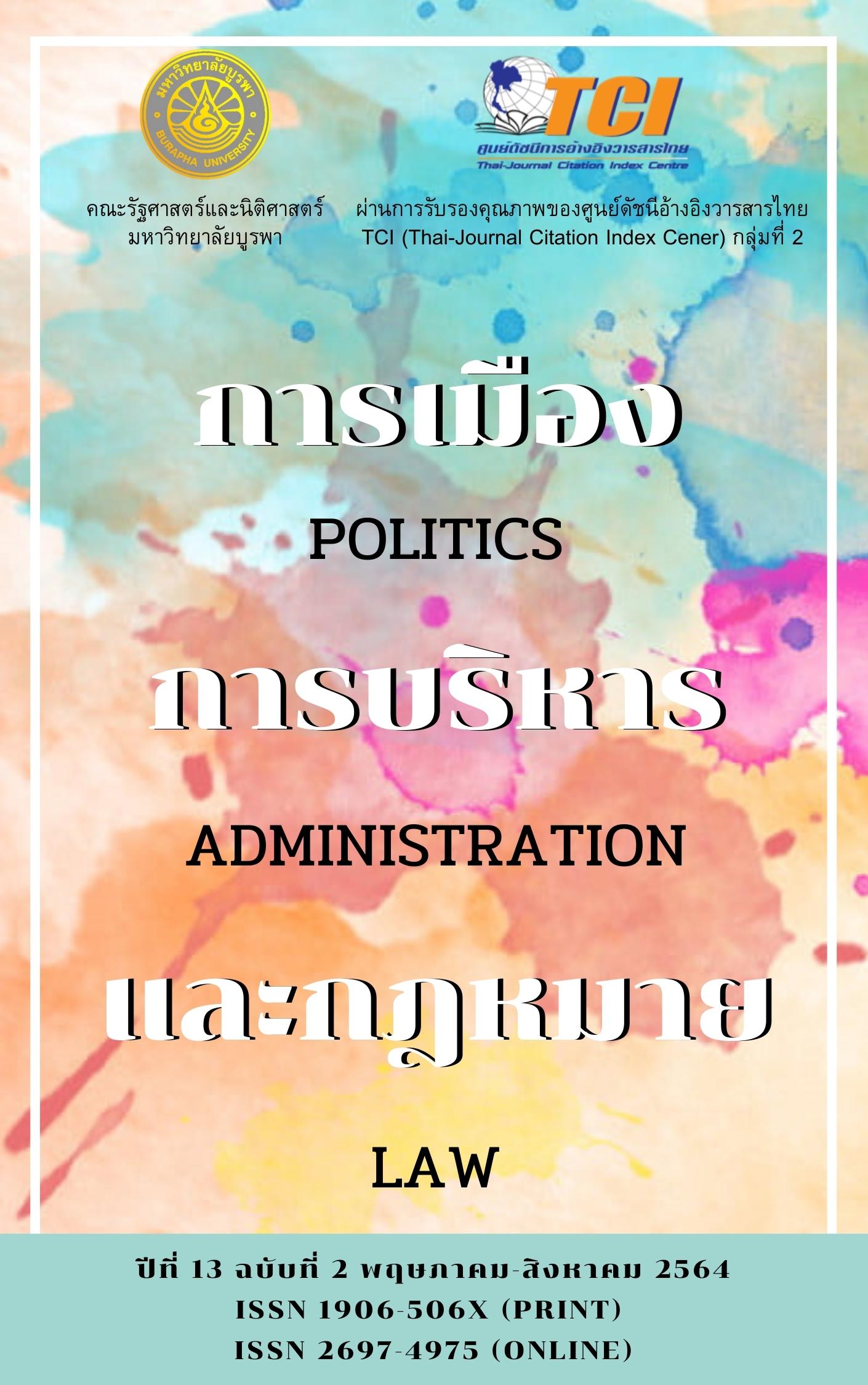การวิเคราะห์ปัญหาและอุปสรรคการจัดการศึกษาของเด็กไร้สัญชาติในประเทศไทย
คำสำคัญ:
การจัดการศึกษา, เด็กไร้สัญชาติบทคัดย่อ
การวิจัยครั้งนี้มีจุดประสงค์เพื่อศึกษาการดำเนินการตามนโยบายการศึกษาสำหรับเด็กไร้สัญชาติ เพื่อศึกษาปัญหาและข้อจำกัด ในการนำนโยบายการศึกษาไปปฏิบัติ และเพื่อเสนอแนวทางการจัดศึกษาที่เหมาะสมสำหรับเด็กไร้สัญชาติในประเทศไทย ซึ่งรูปแบบในการวิจัยครั้งนี้เป็นระเบียบวิธีวิจัยเชิงคุณภาพ การได้มาซึ่งข้อมูลที่สำคัญคือการวิจัยเอกสารและการสัมภาษณ์แบบเจาะลึกโดยมีผู้ให้ข้อมูลที่สำคัญ ได้แก่ ผู้บริหารระดับสูงจากกระทรวงศึกษาธิการ ผู้บริหารจากสำนักงานคณะกรรมการสถานศึกษาขั้นพื้นฐาน (สพฐ.) ภาคตะวันออก จากผู้อำนวยการและครูในสถานศึกษา ในจังหวัดชลบุรี จำนวน 8 ราย ผลการวิจัยพบว่าการนำเสนอผลการศึกษาในส่วนนี้ผู้วิจัยได้นำเสนอออกเป็น 2 ใหญ่ๆ ดังนี้คือ โครงสร้างการจัดการศึกษาเด็กไร้สัญชาติในประเทศไทย การจัดโครงสร้างการจัดการศึกษาเด็กไร้สัญชาติของประเทศไทย เป็นโครงสร้างระบบราชการ การบริหารแบบ Top down การสั่งการเป็นแนวดิ่งเน้นการรวมศูนย์ที่ส่วนกลาง มีลำดับชั้นบังคับบัญชามาก มีความเป็นทางการสูง การปฏิบัติงานถูกกำหนดโดยมีระเบียบเป็นตัวกำกับโดยมิได้ศึกษาความพร้อมของพื้นที่ นโยบายขาดความชัดเจน มีปัญหาในทางปฏิบัติและทำให้เกิดความล่าช้าและรัฐธรรมนูญแห่งราชอาณาจักรไทยโดยมติรัฐมนตรี ที่ได้ออกมาเป็นเวลานานแล้ว ควรต้องมีการแก้ไข และปรับปรุงให้ทันยุคสมัย โดยอ้างอิงจากข้อมูลจริง สถานที่จริงและความต้องการของครูและเด็กนักเรียนไร้สัญชาติในพื้นที่ต่างๆ อย่างทันเวลาและทันสมัย จากผลการวิจัย ได้เสนอแนวทางทางการจัดศึกษาที่เหมาะสมสำหรับเด็กไร้สัญชาติในประเทศไทย ดังนี้ รูปแบบการจัดการศึกษาสำหรับเด็กไร้สัญชาติ ควรจัดแบบผสมผสาน ทั้งการศึกษาในระบบ การศึกษานอกระบบและการศึกษาตามอัธยาศัย เพื่อเป็นการสร้างโอกาสและทางเลือกทางการศึกษาให้แก่ผู้เรียน และตอบสนองความต้องการของผู้เรียน เนื้อหานโยบายหลักสูตรไม่สอดคล้องกับทักษะที่จำเป็นในศตวรรษที่ 21 เน้นคุณลักษณะและเจตคติมากกว่าทักษะสากลที่จำเป็น หลักสูตรมีลักษณะอนุรักษนิยมสูงให้ความสำคัญกับพื้นฐานความเป็นไทย โดยมีลักษณะเด่นที่การมุ่งเน้นคุณธรรมจริยธรรม ความรักชาติ ศาสน์ กษัตริย์และเศรษฐกิจพอเพียง ขณะที่การนำนโยบายหลักสูตรสู่การปฏิบัติยังคงเป็นแบบทฤษฎีบนลงล่างสอดคล้องกับการบริหารราชการแบบรวมศูนย์อำนาจค่อนข้างมาก อำนาจการตัดสินใจด้านการบริหารบุคคลอยู่ในระดับเขตพื้นที่ นอกจากนี้ การที่หลักสูตรมีหลายกลุ่มสาระขณะที่ครูมีภาระงานอื่นนอกเหนืองานสอนในปริมาณมากนับเป็นอุปสรรคสำคัญทำให้ครูไม่ได้มีเวลาอยู่กับผู้เรียน การจัดการเรียนการสอนยังคงเน้นการบรรยายบอกเล่าท่องจำและครูยังคงมีบทบาทสำคัญเป็นศูนย์กลางการเรียนรู้มากกว่าที่จะเน้นผู้เรียนเป็นศูนย์กลางและให้ผู้เรียนได้เรียนรู้ในแบบการสร้างความรู้ด้วยตนเอง
เอกสารอ้างอิง
ทศพร ศิริสัมพันธ์. (2546). เทคนิควิธีการวิเคราะห์นโยบาย. กรุงเทพฯ: สำนักพิมพ์แห่งจุฬาลงกรณ์มหาวิทยาลัย.
ไพศาล บรรจุสุวรรณ. (2558). การนำนโยบายหลักสูตรการศึกษาขั้นพื้นฐานไปปฏิบัติ ในเขตพื้นที่การศึกษา จังหวัดสุราษฏร์ธานี. กรุงเทพฯ: มหาวิทยาลัยธรรมศาสตร์.
บุบผา อนันต์สุชาติกุล. (2554). รูปแบบและการจัดการศึกษาแก่ทายาทรุ่นที่สองของผู้ย้ายถิ่นจากประเทศพม่า. กรุงเทพฯ: สำนักงานเลขาธิการสภาการศึกษา.
นิติพล คงสมบูรณ์. (2559). ปัญหาในการจัดการศึกษาส าหรับเด็กไร้รัฐไร้สัญชาติในประเทศไทย. กรุงเทพฯ: มหาวิทยาลัยธรรมศาสตร์.
เสริมศักดิ์ วิศาลาภรณ์. (2535). สภาพการจัดการศึกษาให้กับนักเรียนชายขอบในจังหวัดชายแดนของไทยที่ติดกับประเทศกัมพูชา. กรุงเทพฯ: จุฬาลงกรณ์มหาวิทยาลัย.
สุภาพร ชาวสวน. (2563). รูปแบบการจัดการศึกษาให้เด็กไร้สัญชาติในภาคตะวันออกของประเทศไทย. สงขลา: มหาวิทยาลัยสงขลานครินทร์.
แสงเทียน คำปัญญา. (2558). สภาพปัญหาและอุปสรรคการบังคับใช้กกหมายทางการศึกษาแก่บุคคลที่ไม่มีสัญชาติไทยของจังหวัดเชียงใหม่. เชียงใหม่: มหาวิทยาลัยราชภัฎเชียงใหม่.
ยุตติชน บุญเพศ. (2555). ความพร้อมในการจัดการศึกษาเพื่อการให้บริการทางการศึกษาแก่ ประเทศสาธารณรัฐประชาธิปไตยประชาชนลาวและราชอาณาจักรกัมพูชา. วารสารการศึกษาและพัฒนาสังคม, 8(1), 73-84.
วรเดช จันทรศร. (2551). ทฤษฎีการนํานโยบายสาธารณะไปปฏิบัติ (พิมพ์ครั้งที่ 2). กรุงเทพฯ: บริษัทพริกหวานกราฟฟิคจํากัด.
วรเดช จันทรศร. (2557). ทฤษฎีการนํานโยบายสาธารณะไปปฏิบัติ (พิมพ์ครั้งที่ 7). กรุงเทพฯ: บริษัทพริกหวานกราฟฟิคจํากัด.
ศุภชัย ยาวะประภาษ และปิยากร หวังมหาพร. (2552). นโยบายสาธารณะไทย: กำเนิด พัฒนาการ และสถานภาพของศาสตร์. กรุงเทพฯ: จุดทอง.
Anderson, E. (2011). Democracy, Public Policy, and Lay Assessments of Scientific Testimony. Episteme, 8(2), 144-164.
Dror, Y. (1968). Public Policymaking Reexamined. San Francisco: Chandler Publishing Company.
Hargrove, E. C. (1975). The Missing Link: The Study of the Implementation of Social Policy. Washington, DC: Urban Institute.
Hogwood, B., & Gunn, L. (1984). Policy Analysis for the Real World. Oxford: Oxford University Press.
Jones, C. O. (1977). An introduction to the study of public policy. Massachusetts: Duxbury Press.
Lasswell, H. D. (1956). The decision process: seven categories of functional analysis. College Park, Md.: Bureau of Governmental Research, College of Business and Public Administration, University of Maryland.
Pressman, J. L., & Wildavsky, A. B. (1973). Implementation: how Great Expectations in Washington are Dashed in Oakland: Or, Why It's Amazing that Federal Programs Work at All, this Being a Saga of the Economic Development Administration as Told by Two Sympathetic Observers who Seek to Build Morals on a Foundation of Ruined Hopes. California: University of California Press.
ดาวน์โหลด
เผยแพร่แล้ว
ฉบับ
ประเภทบทความ
สัญญาอนุญาต

อนุญาตภายใต้เงื่อนไข Creative Commons Attribution-NonCommercial-NoDerivatives 4.0 International License.






